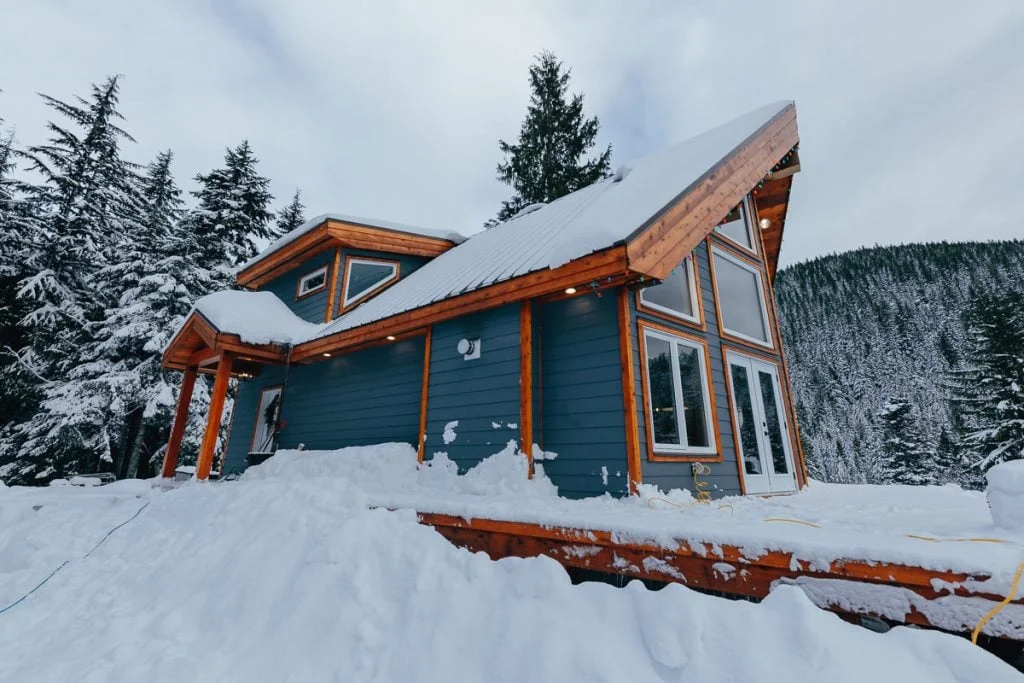At Linwood Homes, we’ve designed and built homes in over 25 different countries. We specialize building across North America. We’ve built many projects in regions with harsh weather conditions such as high precipitation and heavy snow. Often clients wonder if our designs can be customized for their local weather conditions and the answer is, yes, absolutely they can.
There are several reasons why someone might be interested in building a home with a high snow load capacity:
Location
If the home will be built in an area that is prone to heavy snowfall, it may be necessary to build the home with a high snow load capacity in order to ensure that it is safe and structurally sound.
Safety
A home with a high snow load capacity is able to withstand the weight of heavy snowfall, which can help prevent structural damage and collapse. This can be especially important in areas that are prone to heavy snowfall.
Personal preference
Some people may simply prefer the peace of mind that comes with knowing their home is able to withstand heavy snowfall.
Resale value
As mentioned above, a home with a high snow load capacity may be more appealing to potential buyers, which could potentially increase the resale value of the home.
Durability
A home that is built to withstand heavy snow loads is likely to be more durable overall, as it has been designed and constructed to withstand the additional stress of heavy snowfall.
Energy efficiency
A home with a high snow load capacity is likely to be better insulated and more energy efficient, as it has been designed to keep out cold air and reduce heat loss. This can help lower energy bills and reduce your carbon footprint.
How Can a Home Be Customized for Increased Snow Load?
With that being said, there are many ways that homes can be customized to account for increased snow load. Some options include:
- Adding additional support to the roof structure to increase its weight-bearing capacity
- Using heavier and stronger materials for the roof, such as steel or engineered wood
- Increasing the pitch or slope of the roof to allow snow to slide off more easily
- Adding overhangs to the eaves to prevent snow from accumulating on the sides of the roof
- Installing heated cables or blankets on the roof to prevent ice dams from forming
At Linwood, our structural engineers will be able to assess the specific snow load needs for your home based on your location and local regulations. 🙂
Here are some examples of projects where we’ve custom designed homes for areas with a high snow load:

A sloped roof can help with a high snow load by allowing snow to slide off the roof more easily. This can prevent the snow from accumulating on the roof and putting too much weight on the structure. A steeply sloped roof is more effective at shedding snow than a shallow slope. However, it’s important to note that a sloped roof alone may not be enough to adequately support a very high snow load. Additional measures, such as installing snow guards or adding support to the roof structure, may also be necessary.

Likewise, reinforced beams can help with snow load. This can be especially important in areas with heavy snowfall, where the roof may need to support a large amount of snow.

Reinforcing the beams of a roof can be done in a variety of ways, such as adding additional beams, increasing the size of the existing beams, or adding structural supports to the beams. These measures can help to distribute the weight of the snow more evenly across the roof, reducing the risk of structural damage.
From a stylistic perspective, heavily sloped roofs and reinforced beams create a very beautiful interior look. Vaulted ceilings are often considered to be stylistically appealing for a few reasons. They add height and a sense of spaciousness to a room, which can make it feel more open and airy.

This can be particularly appealing in smaller or more cramped spaces. Second, vaulted ceilings can add visual interest to a room by creating a unique shape or architectural feature. The curves and angles of a vaulted ceiling can add a sense of drama or grandeur to a space. Finally, vaulted ceilings can allow for more creative lighting and decorating options, such as hanging chandeliers or other large fixtures or displaying tall or oversized art pieces.

Some roofing materials are better at handling heavy snow load than others. For example, metal roofing and slate roofing can both be good options for heavy snow load, as they are strong and able to support the weight of the snow.
In conclusion, building a home that can withstand heavy snow load is important for ensuring the safety and durability of the structure. Some key factors to consider when designing a home for heavy snow load include the slope and material of the roof, the strength and reinforcement of the underlying structure, and the use of snow retention systems.
By taking these factors into account, it is possible to design a home that is able to withstand the weight of heavy snowfall, protecting the structure and its occupants. It is always a good idea to consult with a professional roofing contractor or structural engineer when designing a home for heavy snow load to ensure that it is properly engineered and able to support the weight of the snow.








